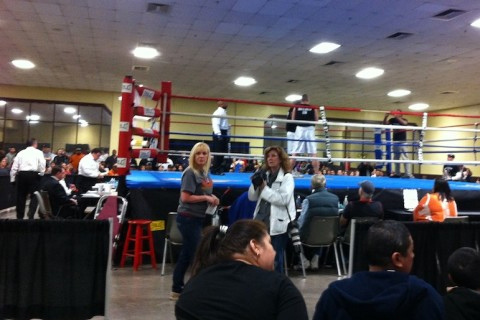Austin’s Golden Gloves: Amateur Boxers Find Themselves in the Ring

Austin’s 2013 regional Golden Gloves fights were January 29 through February 1. These regional tournaments give amateur boxers a chance to get some experience in the ring and possibly move on to state-level fights.
I went to the fights because I have fallen in love with combat sports, including boxing. Last year, at age 40, I ventured into the Fit Pit to take some boxing lessons and was lucky enough to get Art Cardenas as my coach.
Coach Art is the manager of Austin’s regional Golden Gloves tournaments. Austin had lost its Golden Gloves region back in the 1980s, but Coach Art petitioned to get Austin back on the boxing map, and he’s been managing our region’s Golden Gloves since 2010.
When I showed up for nights 3 and 4 of this year’s tournaments, I was eager to see if he’d been able to translate the serious but almost joyful atmosphere of his small gym to the giant hall of the Expo Center.
Yes, he had. A boxing ring dominated center of the huge hall. Around it, spectators claimed the best seats they could or mingled with the boxers who paced around the edges of the room. Boxers and spectators alike looked like a mix of somber determination and nearly unrestrained giddiness.
Some boxers stayed in one of the two curtained areas reserved for them and their coaches. Some found a quiet corner and practiced combinations, warming up and staying calm. They’d had to be at the Expo Center by 5 p.m., fights didn’t start until 7, and some bouts wouldn’t start until after 10. That’s a long time to wait with your loved ones peeking over at you nervously and other fighters knocking each other out in the ring.
Nhan Pham, a Muay Thai instructor from Austin Kickboxing Academy, fought on one of the nights I wasn’t there and was a corner coach for fighters from his gym on the other nights. He told me that the Golden Gloves tournaments are a great way to get introduced to fighting for real. “Once you get into boxing,” he said, “you kind of want to test yourself.”
These tournaments are a well-regulated, safe way to do that—definitely better than starting a fight on Sixth Street.
While some boxers fought “unattached,” most of them were there as representatives of a boxing gym (see the list of gyms at the end of this post). Fighters and coaches from each gym tended to find a place around the edges of the room where they’d gather to talk strategy and wrap hands.
When the fighters went to the ring for their bouts, some just went quietly with their corner coaches, some went accompanied by the other fighters from their gym, and one group—I never caught the name of their gym—wore t-shirts that said PIT and marched their fighter in, chanting, “What time is it? PIT TIME!”
I spent the most time talking to boxers from the Fit Pit, since some of them recognized me from my embarrassing attempts to jump rope and work a speedbag at the open and close of my workouts with Coach Art. But I also talked to any fighters who would make eye contact with me as I wandered around. A lot of them wore earbuds and carefully kept their gazes unfocused, staying in their own heads, but others seemed to welcome the chance to talk.
Austin’s tournaments are every January, and fighters from age 16 and up can compete. (Technically, 17 is the youngest a fighter can be, but the rule is that they have to be 17 before the end of 2013.) Winners of bouts in the early part of the week went on to fight later in the week for a championship trophy.
The boxers fight in divisions based on experience: Sub-novice = 0 fights; Novice = 1 to 10 fights; Open = more than 10 fights; and there’s a Master division that’s for people over 35, regardless of experience. I won’t lie. I kept on eye on the Master competitors, comparing their skill and movement to mine and dreaming teeny little dreams of being in that ring myself someday. Male fighters in the Open division who won championship bouts in Austin will go on to fight in the state tournament in Fot Worth later this month.
The fighters are matched up within divisions based on weight. Each fight goes for three rounds unless there’s a KO or TKO or the ref stops the fight. But rounds are different lengths depending on the experience of the fighters—the most experienced have 3-minute rounds, and the least experienced have 1-minute rounds.
Various boxing gyms from Austin and surrounding areas brought in fighters. And in some cases, the divisions and weight classes worked out so that people from the same gym had to fight each other.
Tyler Richlen, a 26-year-old kickboxer, told me before his fight that he was doing the Golden Gloves because he can’t find many kickboxing tournaments in Texas. He was matched up against Kendall Sawyers, one of his training partners at South Austin Gym. Richlen was philosophical about it: “I wouldn’t be here at all if I didn’t have him as a training partner.” Both men fought well, but Sawyers won by decision. Afterward, the two gleefully compared notes on which punches had landed the hardest.
I asked Richlen after the fight if he knew that he’d been grinning the whole time, and he said, “If you’re not having fun fighting, you’re doing it for all the wrong reasons.” I’m pretty sure I said the same thing to my horrified mother when I told her about my new hobby.
Two other young fighters who won their early bouts ended up in a championship bout on Friday night. Isaac Lopez and Brandon Hernandez train together several times a week at the Fit Pit. (Here’s a Fox 7 story about Isaac and his mother Maria, who also boxes and practices jiu-jitsu.)
Their fight was a great matchup, and a fun fight to watch, but the spectators were torn. For all the fights, groups from each gym would cheer for their fighters, but when Lopez and Hernandez got into the ring together, the Fit Pit crowd fell silent, not wanting to cheer against either of their boys. Finally, a woman in their group solved the problem by yelling, “Go, Fit Pit!” And some of the other Fit Pit fans took up the call.
The fights I was most interested in seeing were the women’s fights, and there weren’t many. Several women won by default, since there was no one in their division and weight class to fight. It’s a common problem in amateur fights, especially for women, since there are a lot fewer women in the sport. Brittany Anne Robertson, from Austin Kickboxing Academy, was disappointed when her opponent ended up getting injured before their bout—it’s hard to know what to do with the buildup of energy from all the physical and mental preparation that now has no outlet.
On the last night, there were two women’s championship bouts. Leesa Daniel won her bout against Anayeli Sequra and also won the award for Outstanding Female Boxer in her division. Before her fight, she told me she was looking forward to it: “I feel really good, really excited. I hear Segura’s a good fighter and I hope it will be a great fight.” It was one of the most exciting fights I saw either night I was there. Both of them kicked some butt.
Janae Hildreth and Jenna Crank also fought a good three rounds, and Hildreth won by decision. I didn’t manage to track down Crank for an interview, but I talked to Hildreth. She also trains at the Fit Pit, and she’s been boxing for less than a year.
The fighters who trained hard and were brave enough to climb into the ring with hundreds of people watching were there for all kinds of reasons. Some of them—especially the younger ones—are hoping to make it to the Olympics or go pro one day. Others, like Hildreth, who just found boxing in her early 30s, smiled at the ring behind me when I asked why she was planning to do as many amateur fights as possible. “I just want to find out what I can do.”
Facts:
- Almost 2,000 people attended the tournament over the four-day period.
- More than 100 boxers registered for the tournament, though not all of them were able to be matched up.
- There were more than 60 bouts.
Gyms that brought boxers (compiled from the bout sheets for each day):
- Arciniega Boxing, http://www.facebook.com/pages/Arciniega-Boxing/222745787788704
- Austin Kickboxing Academy, http://www.austinkickboxingacademy.com
- Azteca Pride, http://www.aztecaprideboxinggym.com
- Fight Factory, http://www.texasfightfactory.com
- Fit Factory
- Fit Pit, http://www.fitpitaustin.com
- JR Boxing
- Perazim Boxing, http://www.roundrockboxing.com
- Richard Lord’s Gym, http://www.lordsboxing.com
- South Austin Gym, http://southaustingym.com
- Southside Warrior, https://www.facebook.com/southsidewarriorboxing?fref=ts [Here’s a cute story about this gym: http://vimeo.com/55948312]






